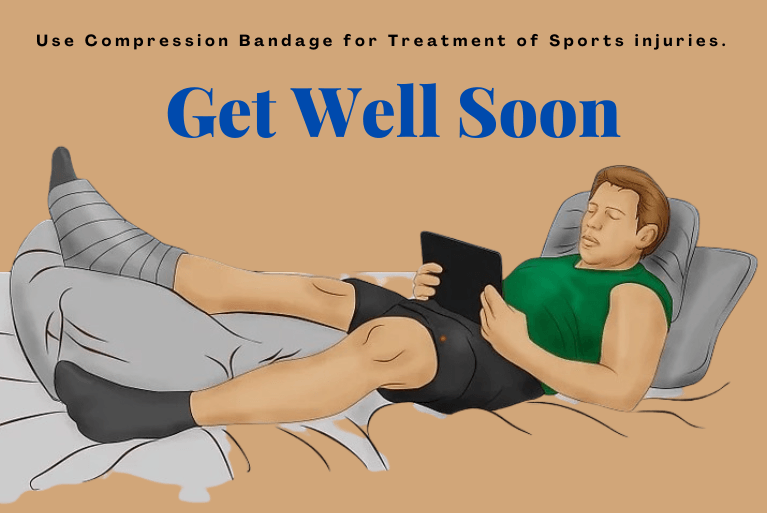
Using Compression Bandage for treating Sports Injuries
Jul 25 , 2022
0 Comments
Introduction
With all the excitement, enthusiasm, team spirit, joy, and physical wellness, a significant part of participating in sports and physical activities is tackling injuries and recovering from them. Individuals need to be physically fit so that they can give their hundred percent to their teams. To do this, they need to recover from their injuries properly. First, let's shed some light on what kind of injuries a sportsperson can get while they're on the field.
- Sprains - Ligaments are tissues that connect two bones in a joint. Sprains happen when the ligaments are overstretched or torn. For a sportsperson, sprains are common in the ankle area.
- Strains - Tendons are the muscles that connect the bones and the muscles. The tearing or overstretching of these tendons results in a strain.
- Knee Injury - These types of injuries affect the motion of the knee.
- Fractures and dislocations - A breaking or dislocation of bones out of their sockets.
- Rotator cuff injury - Four pieces of muscles form a rotator cuff. An injury in one of these muscles is called a rotator cuff injury.
Recovering from these sports injuries is vital for a sportsperson to get back into the game. To do so, they can practice the RICE method (rest, ice, compress, and elevate). While the first two steps of the rice method are easy to execute, the compression part will require the assistance of a compression bandage, also known as a compression wrap or an elastic bandage wrap.
What is a compression bandage?
A compression bandage, also called an elastic bandage, a compression wrap, or an elastic bandage wrap is a long strip of stretchable cloth that can be wrapped around the area of the injury.
How do they work?
Compression wrap or elastic bandage wrap, when wrapped around the area of the injury, reduce the swelling caused due to the injury. They help the blood flow properly in the injured area and push the extra fluids out, resulting in the reduction of swelling.
Types of Compression Bandage
There are two types of compression wrap - inelastic or short-stretch compression Bandage and long-stretch elastic bandages. As the name suggests, the significant difference between the two is the amount of stretch. Short-stretch bandages provide high pressure and are more effective in reducing the swelling around the area of the injury. Long-stretch elastic bandages are used to treat strains and sprains and to support and provide relief to tendons, muscles, and ligaments.
How to pick the right size?
The size of the compression bandage or elastic bandage wrap majorly depends on the body part it is going to be used on. The width of the compression wrap might vary from 2 inches to 6 inches. Choosing a suitable elastic bandage wrap for specific body parts is vital as a compression wrap that is too narrow can cut off blood circulation, and an elastic bandage wrap too broad may not provide enough compression.
For instance, a 6-inch compression wrap can be used on the chest and thigh, a 3-4 inch compression wrap can be used on an adult limb, and a 2-inch elastic bandage wrap can be used on adult fingers or children’s limbs.
How to use it?
Now that we know what compression bandages or elastic bandage wraps are, what purpose they serve, and we’ve picked the right size for our injuries, let’s look at how these bandages are used. Let’s say you injured your wrist playing basketball. How would you use a compression wrap? Here’s how -
- Roll up the bandage.
- Place the end in the palm of your hand and start wrapping it between the thumb and the index finger.
- Keep wrapping towards the wrist.
- Cover your wrist and overlap several times.
- End the wrap a few inches above the wrist.
- Secure the end with tape.
The process of using the compression wrap on any other part of the body is similar. The steps you need to remember are as follows:
- Hold one end of the compression bandage steady and wrap it a few times.
- Cover the area of the injury adequately, making sure that it is not too tight and not too loose.
- Start and end a few inches above and below the injury, respectively, to make sure that the elastic bandage stays in place.
Dos and Don’ts
Elastic bandage wraps are very easy to use and, if used correctly, can speed up the recovery process. But, if used the wrong way, it can make things worse. So, here’s a list of things you need to keep in mind while using an elastic wrap to make sure that it does more benefit than harm -
- Use an elastic wrap during the injury's first 24 to 48 hours.
- As mentioned, wrapping the compression bandage too tight can cut blood circulation.
- Remove the bandage a couple of times daily and wait for a while before wrapping it again.
- Do not use the compression bandage to prevent an injury.
- Don’t apply ice with the bandage, and make sure you rest properly.
A compression bandage can be of great help if used immediately after the injury and can speed up the recovery process. A sportsperson should always have an elastic bandage wrap in case they need it. As mentioned above, they are effortless to use and easy to carry. We’ll be happy to assist you if you're looking for one. Get elastic bandage wraps of all sizes and various brands on Axiom.
or contact us at -- (917)-564-6763
